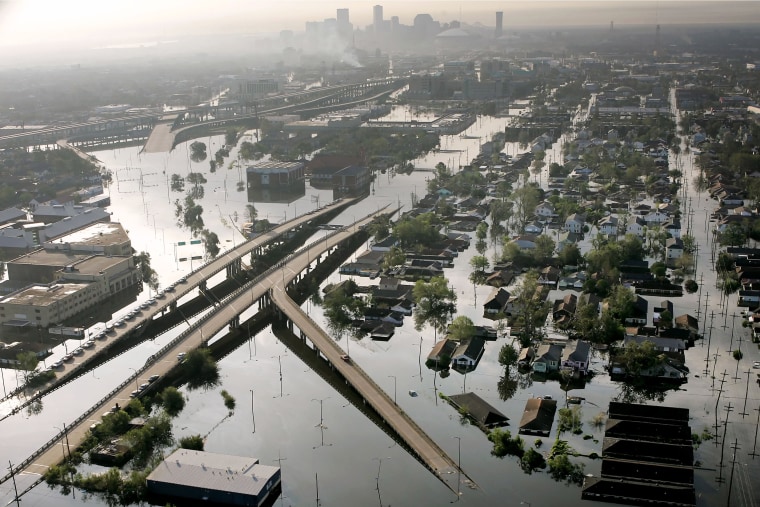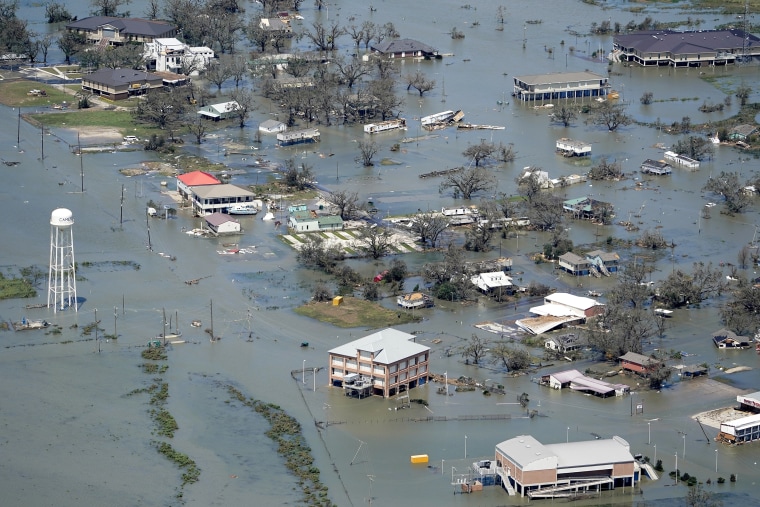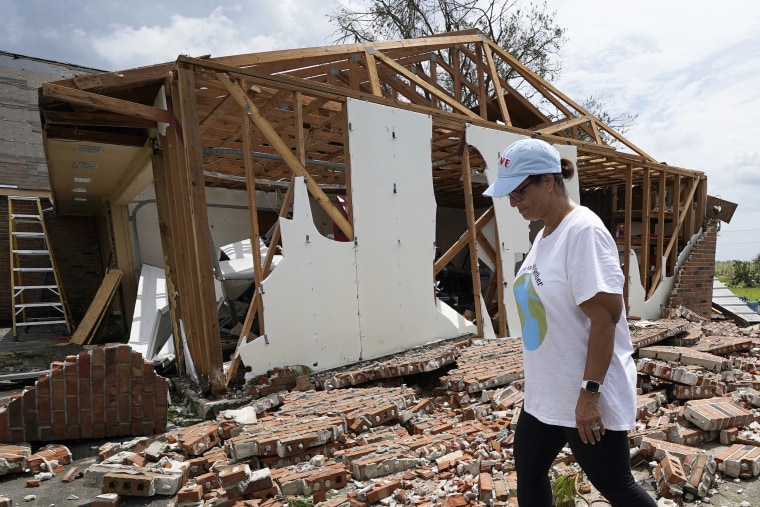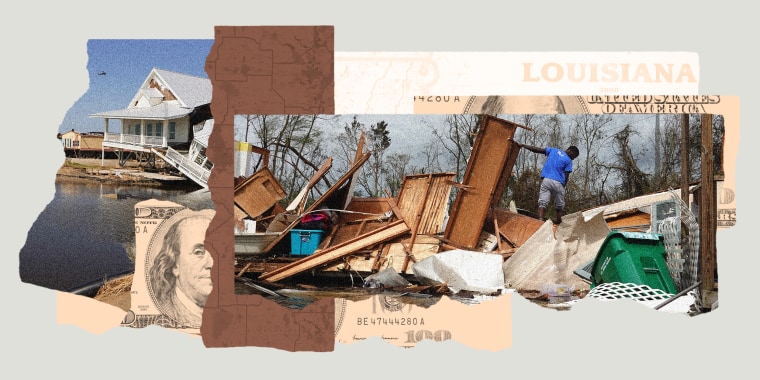Tens of thousands of people are scrambling for homeowners insurance in Louisiana at the peak of hurricane season after recent storms drove their carriers out of business. The crisis has sent insurance prices soaring and stoked fears that the Gulf Coast will grow too expensive to inhabit as climate change fuels more destructive weather.
Homeowners in some disaster-prone areas, including New Orleans, are seeing their premiums double, with some required to pay an extra $3,000 per year. That is on top of a steep rise in the cost of everyday goods, from groceries to gas, as well as energy bills and flood insurance.
The slow-moving meltdown of the homeowners insurance market, which has a tangle of causes and no clear solution, has left many Louisiana residents with a difficult choice: pay more for insurance, reduce their coverage, or go without it entirely.
“Where do you turn?” asked Amanda deVilleneuve, 34, a teacher in Slidell. She and her husband, an oil worker, have two young children and thousands of dollars in debt from the Covid-19 economic downturn. Since Hurricane Ida damaged their roof beyond repair a year ago, her insurance company raised her premium so high that it was cheaper to buy a policy from a state-run carrier of last resort, Louisiana Citizens Property Insurance Corp. They now pay $4,600 a year, up from $2,400, deVilleneuve said.
“Do I eventually move because I can’t afford to live here anymore?” deVilleneuve said.
If the crunch continues, it could unravel the insurance market’s recovery from Hurricane Katrina 17 years ago. That turnaround, which focused on enticing small insurers to the state, helped keep real estate costs in southern Louisiana sustainable for middle- and low-income people. But a string of bad storms is unraveling that progress.
The unfolding crisis in Louisiana has raised doubts more broadly about whether people can remain in America’s most disaster-prone areas amid increased storms, floods, heat waves, fires and droughts.
“When I step back, I wonder if this will become a place where people won’t be able to afford to live in Mother Nature’s path,” said Danielle Dauzat, a New Orleans insurance broker who is frantically trying to find new policies for clients. “If we have an active storm season this year, I cannot even … there are no words. I can’t even imagine where we will be.”
‘Sticker shock’
After Hurricane Katrina, Elona Waters tore down her ruined home in New Orleans’ Gentilly neighborhood and rebuilt it 6 feet off the ground to protect from future floods. The 1,500-square-foot house held strong for 15 years — until Hurricane Ida ripped the roof apart in August 2021.
A retired oil company worker who lives off her pension and Social Security, Waters, 75, paid for the $10,500 job herself while she fought with her insurer, Occidental Fire & Casualty Company, over her claim. She finally got a check covering the job last spring.
But before she got the money, her policy came up for renewal. The premium increased from $2,182 a year to $3,000, her biggest one-year increase since just after Katrina, Waters said.
“It’s sticker shock when you go up that much,” Waters said. “But I had no choice.”
On top of that, Waters is paying more for flood insurance and electricity, all on a fixed income. She said she has had to hold off on planned purchases, like a new mattress. “It does make you think before you shop, before you do anything, before you even spend prime dollars to keep your property up so you don’t have to deal with these issues the next time,” Waters said. “It tightens up your money.”
An Occidental spokesperson said the company could not comment on individual claims but that increases in homeowners insurance premiums reflect the growing severity and frequency of catastrophic weather and the rising costs of building materials and labor. Rate hikes “allow us to remain an available market in areas where other insurance carriers are withdrawing,” the spokesperson, Caryn Best, said in an email.

The origins of the current crisis date to 2005, when Hurricane Katrina and Hurricane Rita pummeled the state. Massive claims from those storms drove large national insurance companies to scale back their coverage and remaining companies to jack up rates. That forced tens of thousands of people into the state-run insurer of last resort, Louisiana Citizens Property Insurance, which by law is required to charge higher rates than private insurers to keep it from getting too big and putting the state at financial risk when another big storm hits.
To entice private insurance firms back to Louisiana, the state embarked on an industry-friendly recovery plan that offered small, regional insurance companies a chance to make money writing high-risk policies for households with few options. The state abolished a commission that reviewed rate increases and adopted a statewide building code while also offering cash incentives to companies that took on new policyholders. More than two-dozen companies entered the Louisiana market. With less cash on hand than the national companies, the new players relied on reinsurance — backup coverage to make sure they don’t go broke after a major storm.
The strategy seemed to work: Rates eventually stabilized, although Louisiana remained one of the most expensive states for homeowners insurance. It helped that the state went several years without getting hit by a major hurricane.
Insurance Commissioner Jim Donelon said the recovery program moved tens of thousands of people off the rolls of Louisiana Citizens and into policies held by private insurers, who on average raised rates just 1 percent a year from 2017 to 2021.
“It was incredibly successful, beyond our greatest hopes,” Donelon said.
Then it came crashing down.
A market crunch
In 2020 and 2021, Louisiana was hit by four major hurricanes, a rarity that experts say could become more likely with climate change. More than 600,000 claims poured in, driven higher by the rising cost of building materials and supply chain delays. That pushed the small insurance companies to their financial limits and squeezed reinsurers, who raised their rates. At the same time, some of the insurers faced massive losses in Florida, where roofing scams have driven a surge in claims and lawsuits.
The back-breaking blow came in August 2021, when the last of the four storms, Hurricane Ida, has cost insurers nearly $7 billion in claims paid to homeowners — on top of the $5 billion for the previous three storms, according to the most recent data from the Louisiana Department of Insurance.

One small insurer drawn to Louisiana after Katrina went out of business in July 2021. Six others capsized in the aftermath of Ida. Dozens more stopped writing new policies, raised rates or left the state. Those moves have set off waves of panic among homeowners, who have gone shopping for new policies only to find few choices and higher prices. Many have turned to Louisiana Citizens. The state insurer’s rolls, which totaled 34,500 in August 2020, ballooned to about 110,000 last week. Citizens recently asked the state Department of Insurance for a 63-percent rate increase for homeowners.
“The way things are getting more expensive, people are not going to be able to afford homes,” Tara Thibodaux said.
Thibodaux, 45, a marriage and family therapist, lives in Harvey, Louisiana, in a single-story, three-bedroom home she bought a few months after Hurricane Katrina. This year, Thibodaux said, her annual premium jumped 80 percent, to $3,467, after her insurer, FedNat, pulled out of the state and her policy was taken over by SURE, an insurance company founded in 2021 that specializes in coverage of coastal properties. She said she’s wracked with anxiety about paying not only her insurance bills, but her rising electricity bills, too. And she worries about her neighbors.
“I think we’re going to have people who can float it for a while but in six months can’t anymore,” Thibodaux said. “They’ll cut out the dentist or the doctor. They’re not going to eat out. No extras. Those are going to be the trickle-down effects.”
Travis Lewis, executive chairman of SURE, said in a statement that premiums are rising in Louisiana for three main reasons: the increased frequency and severity of storms; a near-doubling of the cost of reinsurance; and a 30 percent increase in the cost of rebuilding homes.
“Serving challenging markets requires prudent measures and anticipating what the future may bring,” Lewis said. “We are glad that policyholders have trusted us to continue protecting their homes.”
FedNat executives did not respond to requests for comment.
Much of the blame for the crisis has focused on the failed companies. Some insurance agents, industry experts and affordable housing advocates say the insolvent insurers kept their rates artificially low in order to attract customers and failed to buy enough reinsurance.
The critics also say the state Department of Insurance should have prevented those mistakes from happening.
“This is not a fluke of statistical bad luck. This was very clearly a political decision that the Department of Insurance made to undercapitalized insurance companies to allow them to make more profit on the front end and with the state taking the risk on the back end,” said Jesse Keenan, a real estate professor at Tulane University who studies climate change and the economy. “This is about politics. This is about trying to keep the rates lower. This is about the political pressure to lower the rates.”
State Sen. Jeremy Stine, a Republican whose district includes the city of Lake Charles, which is still rebuilding from 2020’s Hurricane Laura, and who has pushed for industry reforms, said the state Legislature needs to understand how much of the responsibility for the mess falls on the state.
“You could argue there’s a reason there’s an insurance commissioner and a Department of Insurance, and that’s to have oversight over the industry, and that’s what we’re trying to figure out,” Stine said. “Was there enough oversight? Did we kick the tires enough to make damn sure these companies had enough reinsurance? For seven companies to go under tells me there wasn’t.”

Michael Barry, a spokesman for the Insurance Information Institute, an industry group, said the failures in Louisiana had nothing to do with how companies priced their premiums or how much reinsurance they purchased. The culprit, he said, were storms that did far more damage than insurers could have planned for. “Really what it comes down to is the last two hurricane seasons have just been extraordinary,” Barry said.
Former executives for the seven failed companies did not respond to messages seeking comment.
Donelon, who runs the Louisiana Department of Insurance, which monitors the financial solvency of insurers and approves rate-hike requests, said his agency has held companies to rules on maintaining surplus and reinsurance.
“We regulate fairly, not by overly regulating the industry but by monitoring and taking action when necessary,” Donelon said.
Donelon, a Republican who is up for re-election next year, said the insolvencies showed that the failed companies’ rates “were inadequately priced for the risk they took on” and that the companies failed to buy enough reinsurance.
He acknowledged that his agency needs to put more resources into scrutinizing companies’ reinsurance coverage.
But Donelon also said that he relied on regulators in states where insurers doing business in Louisiana are headquartered, and on rating agencies to provide “early warnings” of companies struggling financially. Of the seven failed companies, three were based in Louisiana, three in Florida and one in Washington, D.C.
Donelon questioned the work of one rating agency, Demotech, which had given the seven companies a grade of “exceptional” in the months before they failed.
“I would say that brings into serious question the effectiveness of Demotech’s rating service,” Donelon said.
Joseph Petrelli, Demotech’s president and co-founder, defended his company’s work. The companies were healthy enough to survive a string of serious storms leading up to Ida last year, Petrelli said. But claims from Ida overran the companies’ reinsurance coverage and did them in, he said.
Petrelli said the ratings relied on the insurers’ use of a catastrophe-modeling company to determine how much reinsurance to buy — recommendations that in this case fell short. Demotech is now going to require insurers to obtain estimates from multiple modeling firms, he said.
“If I thought we screwed up, I’d be telling you that,” Petrelli said.
Unclear future
Donelon said the state will rebuild the property insurance market again through a combination of tighter regulations and financial incentives for insurers to write policies in Louisiana. The measures include a higher minimum amount insurers need to keep in reserves, which became law over the summer. The state Legislature also approved grant programs — but has yet to provide money for them — that will lure new insurers to the state and help homeowners upgrade their roofs to withstand hurricane-force winds. These steps haven’t yet softened the crisis; last month, another insurer said it planned to pull out of Louisiana.
While state officials try to stabilize the market, it is already clear that the crisis will affect homeowners and taxpayers for years.
The state agency that backs up policies held by insolvent companies, the Louisiana Insurance Guaranty Association, must now cover the failed companies’ unpaid claims and refund their customers’ premiums, which could total as much as $1 billion. The association, known as LIGA, has so far borrowed $600 million and levied another $200 million in assessments on existing companies, which will recoup the costs by raising rates or by claiming state tax credits, LIGA Executive Director John Wells said.
The crisis has stoked worries about whether insurance will become too costly for most people to live in southern Louisiana.
Other states with severe weather-related risks like drought and wildfires could end up in similar predicaments, said Jeff Albright, chief executive of the Independent Insurance Agents and Brokers of Louisiana. “We are the canary in the coal mine, and others may face a similar problem if they have similar bad luck,” he said.

Some lawmakers, insurance brokers and industry analysts say Louisiana may need the federal government’s assistance.
“I don’t see how the private sector stays in a lot of these places, and they may not be able to afford to if we have a couple more big storms,” said state Rep. Mandie Landry, a Democrat who represents part of New Orleans. “So if the federal government wants to be responsible for residents who live here, they need to step in and help us out.”
Landry suggested something similar to the National Flood Insurance Program. But that program has been unable to keep rates affordable or keep up with the cost of claims — the same problems already plaguing Louisiana’s homeowners insurance market.
Dave Jones, a former California insurance commissioner and director of the Climate Risk Initiative at the University of California at Berkeley School of Law, said state and federal government backstops do little to address the much bigger dilemmas posed by climate change.
“The future is not bright in regard to increased catastrophic weather,” Jones said. “The tendency is that we will see more storms of greater severity, and greater losses. So maybe the market in Louisiana comes back for a couple years until the next big storm hits. But it’s not getting better.”

